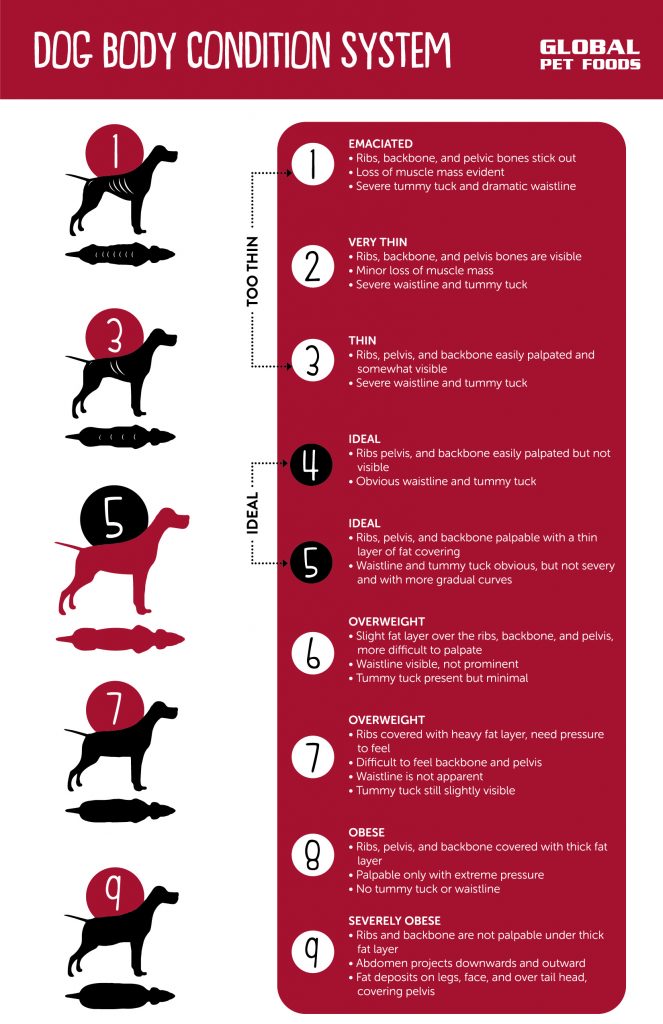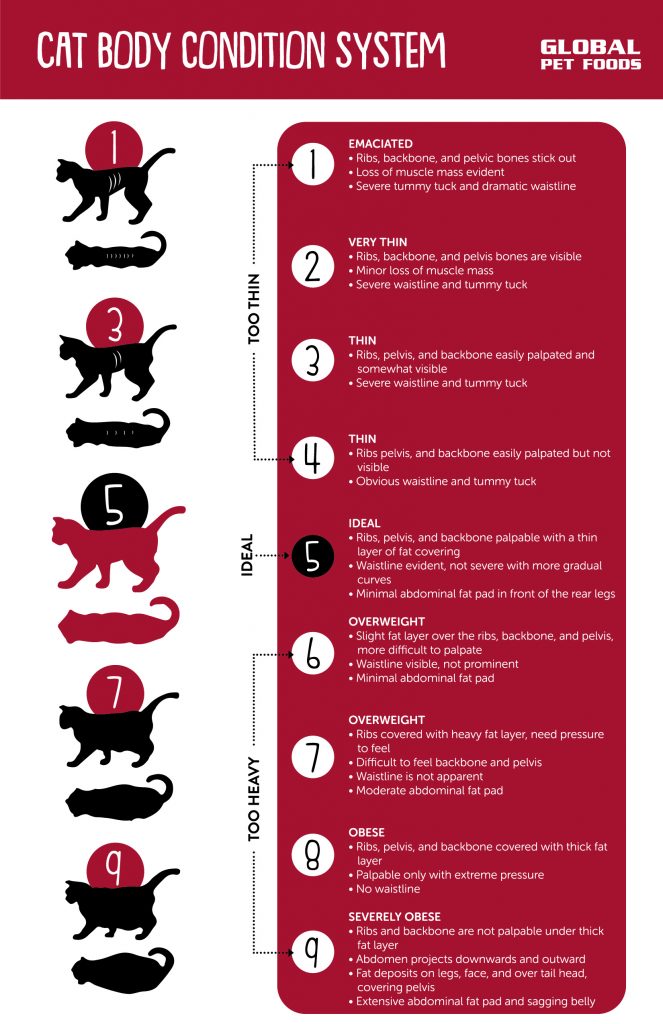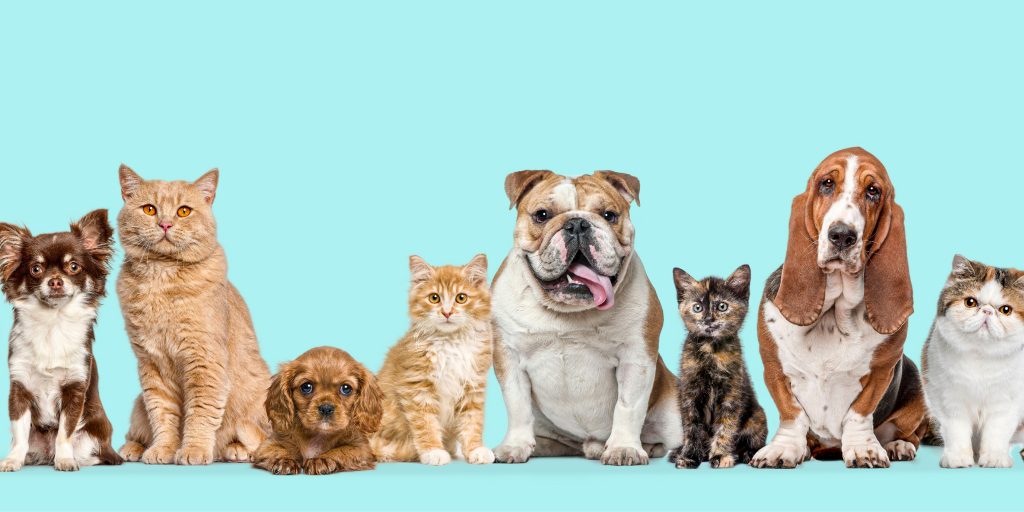In most cases, our furry family members are typically visiting the vet every 6-12 months. Of course, unless they get sick and need to visit more frequently. During the vet visit our pets will have a physical exam and the vet will determine their body condition score (BCS), but a lot can change in 6 months, and especially in 12 months. This is why it is important for us pet parents to know how to determine their body condition score at home.
Pet obesity is the number one nutritional disorder in pets, and it can be very easily managed and monitored. It is not the only concerning condition that BCS can help identify and monitor, but it is estimated that 59% of dogs and 63% of cats are overweight and may be struggling with the health implications that come with it. It is a big issue that we need to tackle. We all want our furry family members to be healthy, happy, and with us as long as possible. Unfortunately, a high body condition score puts them at higher risk of heart disease, diabetes, joint ailments, arthritis, high blood pressure, and surgical/anesthetic complications. BCS can help with better communication with our veterinarians and a better understanding of the risks in order to come up with a treatment plan together.
Typically, owners are focused more on the number on the scale, but measuring body condition can provide more detail on their health. Weight may stay the same while fat percentage increases and lean body mass decreases with age. We can monitor their body condition and health between visits and have the ability to warn our vet team so they can provide any treatment that may be needed. This early intervention may allow for better treatment options and may prevent a disease from occurring or at least worsening.
What is BCS?
We know that people come in all different shapes and sizes and the pet world has an even bigger variety of both, especially with canines. We needed a method that not only can be used accurately for cats and Chihuahuas but also Bulldogs and Great Danes. Despite this variety, we needed a consistent system used by all veterinarians. BCS is the standardized method of predicting a patient’s body fat percentage and assess if they are carrying a healthy amount. To develop and validate the method they used a machine called DEXA, Dual-Energy X-ray Absorptiometry. It uses low doses of radiation to assess the body condition, the proportion that is fat, lean tissue (organs, muscles, etc.) and bone. You may be thinking, “well why don’t we use DEXA machines to determine their condition?”. The machines are extremely expensive and are not available to most veterinary practices, which is why they came up with body condition scoring. BCS is not just opinion, it is a scientifically validated system, and is species specific. It relies on several visual cues as well as palpation of various regions of the body allowing the veterinarian to monitor their health, approximate their ideal body weight and make any recommendations they feel is needed in each individual case.
The System
Veterinarians may use one of two scoring systems, 1-5 or 1-9. The standard BCS is based on the 9-point system as it helps to identify the more subtle changes in condition. Now the scores are not just numbers, they represent a category of body condition and an approximate body fat percentage of our furry friends.


How to Assign a Body Condition Score
Assigning a body condition score involves both a visual assessment and physical touch component through palpation. You will want to visually examine your pet while they are standing facing forward. Having a helping hand to keep their attention and stance is a great idea if possible.
First, we will want to view them from above and we want to see that the waistline curves in between the ribcage and the hips in dogs. We may also see the last rib or two in our canines and that is okay. From above our cats, we want to see a slight inward curve at the waist, but not as defined as dogs. The cats are likely overweight if they have no inward curve or have an outward curve visible from above.
Next up, we will want to examine our furry friends shape from the side. In dogs, we want to see a defined abdominal tuck though the degree of tuck will be varied between breeds. A slight abdominal tuck will may still be visible in overweight or obese patients, but it is more likely to see an outward curve with them. Keep in mind, an abdominal tuck in cats may be a sign they are too thin.
Speaking of our purrfect friends, we want to do a visual and tactile assessment of the abdominal fat pad. There should be a minimal layer of fat, any more could be a sign they are overweight. Many cats who were previously overweight will have a pouch of loose skin.
The last visual aspect of body condition scoring are the bones beneath the skin. We will start with the ribcage. In dogs, being able to see the last 1-2 ribs is healthy and we may be able to see more if they are moving around, sniffing or have a short hair coat. If we are able to see the ribs of our beloved kitties, they are too thin. Now moving along to hip bones or pelvis, if they are visible our furry friend is most likely too thin at a score of 3/9 (2/5) or less. This is also the case if the spine is visible. If the pet has lost weight and possibly muscle mass, other bones may be evident without touch as well.
Palpation
A very important component to body condition scoring is touch, called palpation, especially of the ribcage. Fat will typically accumulate over the top 3rd of the ribcage so this is where we will assess. We want to feel for the fat covering by placing our thumbs on their spine and spreading our fingers across their ribcage and working our way from head to tail. If our pet’s ribcage is easily palpable without applying pressure, they are most likely at a score between 3/9 and 5/9 (2/5 to 3/5). With an emaciated pet with a score of 1/5 or 1/9, they will have a ribcage that is not only easy to feel without pressure but also visible. Obese pets with a score of 5/5 or 9/9 would have a thick layer of fat covering the ribcage making it very difficult and, in some cases, impossible to feel the ribcage. Feeling the ribcage is less uncomfortable for our furry friends then feeling their hips and pelvis, and many may think we are just showing them some love with extra pets. For our arthritic friends, we will want to stick to just the ribcage as they may experience pain with any pressure on their back or hips.
Now, what does a healthy fat layer feel like? There is a great trick using just our hands to demonstrate the feeling. Let’s try it out! Our left hand will represent our furry friend’s ribcage, while our right hand is our hand palpating. First, we will hold our left-hand limp and with the right, feel the bones on the back of our left hand. This is what an ideal fat layer feels like. Now, make a fist with our left hand and feel the knuckles with our right hand. This is what very little fat covering feels like, our pet would be too thin. Lastly, let’s flip our hand over, palm facing up, holding it limp. If we feel our left palm with our right hand, we have to push harder to feel the bones. This represents the ribcage of an overweight pet.
What Do We Do Next?
Now that we know the two scoring systems and how to assess their condition both visually and through palpation, we can give our beloved pets a score. If our cats are at 5/9 or 3/5 and our dogs at 4-5/9 and 3/5 they are at a healthy body condition. Congratulations! From here we know we don’t need to make any changes to their exercise routine or their diet and feeding amount. If our assessment is indicating that our pets are above or below a healthy body condition score, there are a few things we can do but first it is best to discuss with your veterinarian. We will want to ensure there is no underlying condition causing the change in weight and condition before we start switching food amounts or changing their daily activity. Having this knowledge does not replace the need for physical exams, consultations, and diagnosis performed by our veterinarians, but helps monitor health and pass along any insights since our last visit. No matter their score, we suggest monitoring both body weight and body condition every 2-4 weeks and adjusting feeding amount as needed, with the guidance of your pet health team.
If after performing our assessment we are concerned about our pet’s condition, here are a few things to keep track of and document to bring to our next appointment or relay to the veterinarian and team.
- Has their appetite been normal, increased or decreased?
- What kind of food are they eating and how much?
- How and where is the food stored?
- Has there been any changes in their activity level?
- Have they been having any trouble swallowing?
- Has there been any moments of regurgitation or vomiting after eating?
- Have they been drinking more, less or the same amount of water?
- What colour and consistency is their stool?
- Is there any change in volume or frequency when pooping?
- Are they spayed or neutered?
- Do they have a fever or seem excessively tired?
- Are they tested regularly or on regular parasitic prevention?
- Are they on any medications or supplements?
Early Identification of Conditions
Body condition scoring and monitoring weight helps to identify health issues early to provide the best care and treatment that is needed to get them back to feeling their best! Many health conditions may be the underlying cause of our pet very quicky gaining or losing weight. Below we will go over both conditions that may cause them to lose weight and those that may make them gain weight. The more we know the better chance we will have to catch these conditions early before they have a big effect on our pets’ lives.
Conditions Causing Weight Loss
- One of the many conditions that can cause rapid weight loss is diabetes. The condition can start when the body lacks the amount of insulin required to breakdown sugar in the blood or the body is not responding to insulin as it should resulting in high blood sugar. Without the proper levels of insulin or a proper response, our pets’ systems start to breakdown fat and muscle to replace the energy source. This leads to a serious decline in physical health and condition. You may also see a serious decline with other diseases that affect metabolism, such as Addison’s disease and hyperthyroidism (rare in dogs).
- Dental health issues are one of the leading causes of weight loss in pets. They may be struggling with sensitive gums, broken teeth or an abscess that is causing a lot of pain and may make it difficult to chew. To avoid the pain they avoid eating, leading to weight loss and a lack of energy.
- Of course, another condition that can cause drastic weight loss quickly is cancer. Cancer can change the way the body utilizes the nutrients from their diet causing weight loss. This change in condition is typically one of the first symptoms pet parents notice.
- A pet with a heavy parasitic load can experience major weight loss when left untreated. The parasites will utilize the nutrients for themselves and cause them to feel so unwell they may lose their appetite too.
- Malabsorptive disorders such as infiltrative and inflammatory bowel disease (IBD), inhibit their body’s ability to absorb the nutrients in the intestines, leading to weight loss. The same can be said with maldigestion disorders like exocrine pancreatic insufficiency (EPI) which interferes with the breakdown of food into nutrients that are available to the body.
- Now, there does not have to be a serious disease or disorder to cause a drastic change in body condition. Sometimes there are completely normal life changes that occur that have an effect. This can include the introduction of a high demand sport but not increasing their calories. As well as pregnancy, lactation, and prolonged exposure to the cold, can all cause notable changes in their body condition that you can continue to monitor and relay to your pet health team.
Conditions Causing Weight Gain
There are many reasons a pet may gain weight, but it is typically more of a gradual progression over time such as when we are simply feeding too many calories or not getting enough exercise. We are going to go over a few conditions that can cause of furry family members to lose a lot of weight and fast.
- We will start off with hypothyroidism, which is rare in cats. This occurs when the thyroid gland does not produce enough thyroid hormone, slowing down metabolism. This slow down in metabolism is what leads to the weight gain and change in body condition. Even if the pet parents were to reduce the calories, they pet would still gain weight because it is not a food intake issue.
- Cushing’s disease can cause weight gain and bloating. It is an endocrine disorder that causes an increase in cortisol production. It does not always bring a big weight gain but there is an obvious body condition change due to the extreme bloating. Heart disease and cancer can have a similar bloating effect on the body, all can be quite serious and life threatening.
- We are going to bring up parasites again because not only can they cause weight loss, but they can cause a drastic change in body condition through a “potbelly” appearance. This is due to excessive fluid build up near the site of infestation, typically the intestines. This is most seen in puppies and those with an underdeveloped immune system.
- Lastly, many prescription medications can cause significant weight gain in our pets, just like humans. This is especially seen in patients that are on medications long term. The change in body condition can be brought to your veterinarian’s attention who may be able to adjust the dosage or recommend an alternative.
All of these conditions and diseases can be better diagnosed, treated, and managed with early intervention thanks to pet parents monitoring body condition score at home. If you have any questions about checking your furry friend’s body condition score, feel free to reach out to your local Global Pet Foods to speak with their healthy pet care specialists or your veterinarian’s office.
Written By
Taylor Luther
Marketing Lead, Customer Engagement
Taylor completed a Bachelor’s Degree in Animal Biology at the University of Guelph and has built up experience within the pet nutrition industry and the animal medical field. She has a passion to share all insights on pet nutrition and health for all of our furry (feathery, scaly or otherwise) friends.












